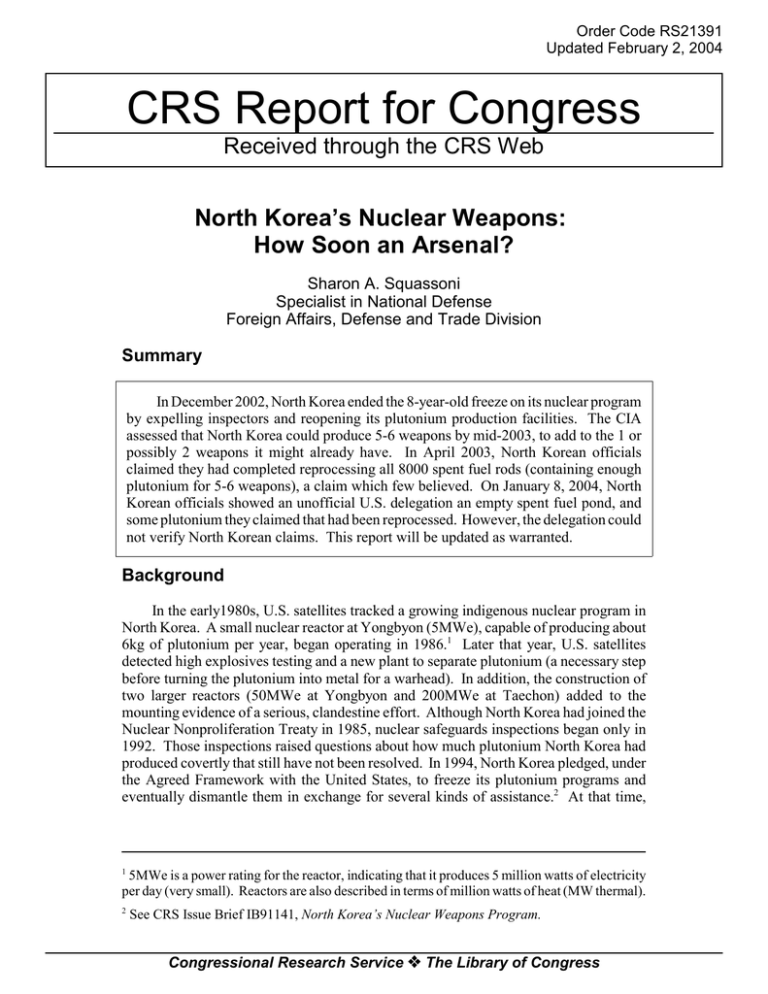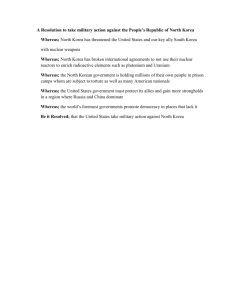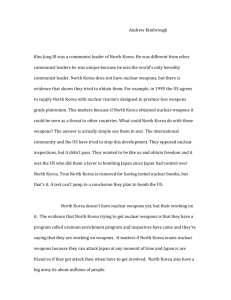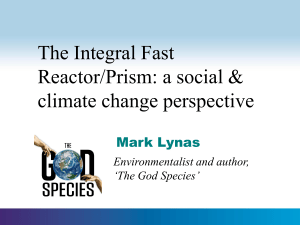CRS Report for Congress North Korea’s Nuclear Weapons: How Soon an Arsenal?
advertisement

Order Code RS21391 Updated February 2, 2004 CRS Report for Congress Received through the CRS Web North Korea’s Nuclear Weapons: How Soon an Arsenal? Sharon A. Squassoni Specialist in National Defense Foreign Affairs, Defense and Trade Division Summary In December 2002, North Korea ended the 8-year-old freeze on its nuclear program by expelling inspectors and reopening its plutonium production facilities. The CIA assessed that North Korea could produce 5-6 weapons by mid-2003, to add to the 1 or possibly 2 weapons it might already have. In April 2003, North Korean officials claimed they had completed reprocessing all 8000 spent fuel rods (containing enough plutonium for 5-6 weapons), a claim which few believed. On January 8, 2004, North Korean officials showed an unofficial U.S. delegation an empty spent fuel pond, and some plutonium they claimed that had been reprocessed. However, the delegation could not verify North Korean claims. This report will be updated as warranted. Background In the early1980s, U.S. satellites tracked a growing indigenous nuclear program in North Korea. A small nuclear reactor at Yongbyon (5MWe), capable of producing about 6kg of plutonium per year, began operating in 1986.1 Later that year, U.S. satellites detected high explosives testing and a new plant to separate plutonium (a necessary step before turning the plutonium into metal for a warhead). In addition, the construction of two larger reactors (50MWe at Yongbyon and 200MWe at Taechon) added to the mounting evidence of a serious, clandestine effort. Although North Korea had joined the Nuclear Nonproliferation Treaty in 1985, nuclear safeguards inspections began only in 1992. Those inspections raised questions about how much plutonium North Korea had produced covertly that still have not been resolved. In 1994, North Korea pledged, under the Agreed Framework with the United States, to freeze its plutonium programs and eventually dismantle them in exchange for several kinds of assistance.2 At that time, 1 5MWe is a power rating for the reactor, indicating that it produces 5 million watts of electricity per day (very small). Reactors are also described in terms of million watts of heat (MW thermal). 2 See CRS Issue Brief IB91141, North Korea’s Nuclear Weapons Program. Congressional Research Service ˜ The Library of Congress CRS-2 Western intelligence agencies estimated that North Korea had separated enough plutonium for one to two bombs; other sources claimed it was enough for 4-5 bombs. Weapons Production Milestones One of the key hurdles in making nuclear weapons is acquiring fissile material – plutonium-239 or highly enriched uranium (HEU).3 Producing these two materials is technically challenging; in comparison, many experts believe weaponization to be a relatively easy process.4 North Korea has industrial-scale uranium mining, and plants for milling, refining, and converting uranium; it also has a fuel fabrication plant, a nuclear reactor, and a reprocessing plant – in short, everything needed to produce Pu-239. In addition, North Korea may be constructing a uranium enrichment plant. In its nuclear reactor, North Korea uses magnox fuel -- natural uranium (>99%U-238) metal, wrapped in magnesium-alloy cladding. About 8000 fuel rods constitute a fuel core for the reactor. When irradiated in a reactor, natural uranium fuel absorbs a neutron and then decays into plutonium (Pu-239). The longer the fuel remains in the reactor, the more it is contaminated by the isotope Pu-240, which can “poison” the functioning of a nuclear weapon.5 Thus, a key consideration is how long the fuel must remain in the reactor to produce optimal plutonium for a weapon. Spent or irradiated fuel, which poses radiological hazards, must cool after removal from the reactor. The cooling phase, estimated by some at 5 months, is proportional to the fuel burn-up. Reprocessing – or separating the plutonium from waste products and uranium – is the next step. North Korea uses a PUREX separation process, like the United States. After shearing off the fuel cladding, the fuel is dissolved in nitric acid. Components (plutonium, uranium, waste) of the fuel are separated into different streams using organic solvents. In small quantities, separation can be done in hot cells, but larger quantities require significant shielding to prevent deadly exposure to radiation.6 Many experts agree that North Korea has mastered the engineering requirements of plutonium production. Its 5MWe nuclear reactor operated from 1986 to 1994, restarting in January 2003. North Korean officials claimed to have separated plutonium in hot cells and tested the reprocessing plant in 1990, and to have separated all 8000 fuel rods from the 5 MWe reactor between January and June 2003. Some analysts have reported that the 5MWe reactor operated at low efficiencies. The January 2004 unofficial U.S. delegation reported that “All indications from the display in the control room are that the reactor is operating smoothly now...However, we have no way of assessing independently 3 Highly enriched uranium (HEU) has 20% or more U-235 isotope; weapons-grade uranium is 90% or more U-235. 4 While the physical principles of weaponization are well-known, producing a weapon with high reliability, effectiveness and efficiency without testing holds significant challenges. 5 Plutonium that stays in a reactor for a long time (reactor-grade, with high “burn-up”) contains about 20% Pu-240; weapons-grade plutonium contains less than 7% Pu-240. 6 Hot cells are heavily shielded rooms with remote handling equipment for working with irradiated materials. CRS-3 how well the reactor has operated during the past year.”7 The same delegation reported that the reprocessing “facility appeared in good repair;” this contrasts with a 1992 IAEA assessment of the reprocessing plant as “extremely primitive.” In the end, however, North Korea’s potential for developing a large nuclear arsenal depends on the completion of the two larger reactors and progress in the reported uranium enrichment program. There is little information on whether North Korea has a workable nuclear weapons design. The simplest nuclear weapon design, a gun-type assembly, cannot use plutonium. Many believe North Korea is capable of manufacturing implosion-type devices, which require sophisticated lenses of high explosives to compress plutonium in the core. As long ago as 1986, U.S. satellites detected high explosives testing with the kind of compression patterns associated with implosion devices, although North Korea claimed the tests were for civilian purposes.8 There have been reports of Soviet scientists aiding North Korea, although CIA officials in the mid-1990s reportedly said that North Korean scientists did not receive training in nuclear weapon technologies from Russia or China.9 A key question is whether North Korea can develop a warhead for its ballistic missiles. Although states that developed nuclear weapons typically used relatively crude delivery methods at first, North Korea has concurrently produced ballistic missiles with sufficient range and payload to carry nuclear warheads. Nonetheless, such a warhead would need to be small and light enough to fit on a missile, and robust and sophisticated enough to tolerate the extreme conditions encountered through a ballistic trajectory. In January 2004, North Korean officials showed an unofficial U.S. delegation what they claimed was “scrap” from a Pu casting operation; the officials stated that the metal was alloyed. Alloying plutonium with other materials, according to Dr. Siegfried Hecker of Los Alamos National Laboratory, is “common in plutonium metallurgy to retain the delta-phase of plutonium, which makes it easier to cast and shape,” and casting plutonium is a step in weapons production.10 Hecker, as a delegation member, assessed that the stated density of the material (as well as the fact that it was not cracked) was consistent with plutonium alloyed with gallium or aluminum. If true, this could indicate a certain sophistication in North Korea’s handling of Pu metal. Nonetheless, Hecker could not confirm that the metal was indeed plutonium, that it was alloyed, or that it was from the most recent reprocessing campaign, without conducting actual tests of the material. Estimating Nuclear Material Production Most estimates of nuclear weapon stockpiles are based on estimates of fissile material production. To determine how much plutonium is produced, one must know: the average power level of the reactor; days of operation; how much of the fuel is reprocessed and how quickly, and how much plutonium is lost in production processes. According to North Korea, the 5MWe reactor performed poorly in the early years, unevenly irradiating the rods. There is no available data on the reactor’s current performance. 7 Siegfried Hecker, January 21, 2004, testimony before Senate Foreign Relations Committee. 8 Don Oberdorfer, The Two Koreas, (MA: Addison-Wesley), 1997, p. 250. 9 David Albright, Frans Berkhout ,William Walker, Plutonium and Highly Enriched Uranium 1996: World Inventories, Capabilities and Policies, Oxford University Press, 1997, p. 307. 10 Hecker, January 21, 2004 testimony before SFRC. CRS-4 Likewise, the reprocessing facility’s efficiency is hard to judge. Before the reported 2003 reprocessing campaign, the reprocessing plant had not operated after the “hot test” in 1990. North Korea told the IAEA that during the 1990 test, it recovered 62 grams of plutonium, losing almost 30% in the waste streams.11 A key consideration is whether or not the reprocessing plant can successfully run continuously, since frequent shutdowns can lead to plutonium losses. According to North Korean officials in January 2004, the plant throughput is 110 tons of spent fuel annually, about twice the amount of fuel in the 5MWe reactor. Finally, North Korea’s technical sophistication will ultimately determine how much plutonium is needed per bomb. Although the international standard is 8kg of Pu per weapon (and 25kg for HEU), technical experts agree that it is possible to make nuclear weapons with less than half that amount. Not many technical experts, however, will speculate on North Korea’s abilities in this area. What Does North Korea Have Now? More recent assessments emphasize that North Korea has assembled weapons. Secretary of State Powell stated in December 2002 that “We now believe they [North Koreans] have a couple of nuclear weapons and have had them for years.”12 An unclassified CIA paper in November 2002 stated that the “North has one or possibly two weapons using plutonium it produced prior to 1992.”13 However, the CIA paper stated that this was an assessment that has not changed since the 1990s. In that time, the CIA consistently reported that North Korea “has probably produced enough plutonium for at least, one, and possibly two, nuclear weapons.”14 Those estimates were based on assumptions that North Korea had separated between 6 and 10kg of Pu in the late 1980s. In addition to this amount of material, analysts must consider the disposition of the fuel rods in the spent fuel pond. At present, there is no consensus on whether they have been reprocessed. Has North Korea reprocessed the existing spent fuel?. On April 17, 2003, North Korean officials announced they were successfully reprocessing plutonium. One week later, officials softened that statement to “successfully going forward to reprocess work.”15 On July 13, 2003, North Korean officials told U.S. officials in New York that they had completed reprocessing the 8000 fuel rods on June 30.16 On January 8, 2004, North Korean officials told the unofficial U.S. delegation that the reprocessing campaign began in mid-January 2003 and ended at the end of June 2003. In all, they reportedly 11 David Albright and Kevin O’Neill, editors, Solving the North Korean Nuclear Puzzle, ISIS Report, ISIS Press, 2000, p. 88. 12 Transcript of Dec. 29, 2002 “Meet the Press” see [http://www.msnbc.com/news/852714.asp] 13 CIA unclassified paper on North Korea dated November 19, 2002. 14 See Acquisition of Technology Relating to Weapons of Mass Destruction and Advanced Conventional Munitions,”[http:// www.cia.gov/cia/publications/bian/bian_jan_2003.htm] 15 “North Korea Shifts Tone on Nuclear Plan,” International Herald Tribune, April 22, 2003. 16 “North Korea Says It Has Made Fuel For Atom Bombs,” New York Times, July 15, 2003. CRS-5 reprocessed 50 tons of spent fuel in less than 6 months. This tracks with earlier estimates that if North Korea reprocessed about 11 tons/month, it might produce enough plutonium for 1 bomb per month. The unofficial U.S. delegation visiting in January 2004 concluded that the spent fuel pond no longer held the 8000 fuel rods and surmised that those fuel rods could have been moved to a different storage location, but not without significant health and safety risks. The delegation was not allowed to visit the Dry Storage Building, where the fuel rods likely would have been stored before reprocessing. If the 8000 fuel rods from the 5 MWe reactor have been reprocessed, they would yield, according to one estimate, between 25 and 30kg of plutonium, enough for 5 or 6 weapons. The exact amount of plutonium that might have been reprocessed is not known. The January 2004 U.S. visitors to the plant were not allowed to visit waste facilities, and North Korean officials did not reveal any operating difficulties with the plant, stating that the reprocessing campaign was conducted continuously (four 6-hr shifts). U.S. efforts to detect Krypton-85 (a by-product of reprocessing) reportedly suggested that some reprocessing had taken place, but were largely inconclusive. Adding to the Arsenal Make New Plutonium. On February 6, 2003, North Korean officials announced that the 5 Mwe reactor was operating, and commercial satellite photography confirmed activity in March. In January 2004, North Korean officials told the unofficial U.S. delegation that the reactor was now operating smoothly at 100% of its rated power. The U.S. visitors noted that the display in the reactor control room and steam plumes from the cooling towers confirmed operation, but that there was no way of knowing how it had operated over the last year. A common estimate is that the reactor generates 6kg of Pu per year, roughly 1 bomb per year, but the reactor would likely be operated for several years before fuel is withdrawn. In 3 years, it could generate about 14-18kg of plutonium, enough for 2 to 3 weapons. Shorter cycles are possible, but would waste considerable fuel. Assuming a 6month cooling period for plutonium, North Korea would be ready to reprocess by August 2006, and ready to convert into metal by February 2007. Bring New Reactors On-Line. The reactors at Yongbyon (50MWe) and Taechon (200MWe) may be several years from completion. U.S. visitors in January 2004 saw no construction cranes, heavy corrosion, and cracks in concrete building structures at Yongbyon, reporting that the reactor building “looks in a terrible state of repair,” but they did not visit the Taechon site.17 The CIA estimates that the two reactors could generate about 275kg of plutonium per year.18 In January 2004, North Korean officials told the unofficial U.S. delegation that they are evaluating what to do with both reactors. 17 Hecker January 21, 2004 testimony before SRFC. 18 CIA unclassified point paper distributed to Congressional staff on November 19, 2002. CRS-6 Produce Highly Enriched Uranium for Weapons. In an unclassified working paper on North Korea’s nuclear weapons and uranium enrichment distributed to Congressional staff on November 19, 2002, the CIA estimated that North Korea “is constructing a plant that could produce enough weapons-grade uranium for two or more nuclear weapons per year when fully operational – which could be as soon as middecade.”19 Such a plant would need to produce more than 50kg of HEU per year, which would require cascades of thousands of centrifuges. The CIA’s unclassified paper noted only that in 2001, North Korea “began seeking centrifuge-related materials in large quantities.” Little is known about the specifications of the North Korean centrifuges. An enrichment program, which the North Koreans alternately have admitted and denied having, offers at least three benefits. Such a program would be more difficult to locate and target than the Pu operations, if military strike options are considered. Second, HEU could give the North Koreans the option of producing either simpler weapons (gunassembly type) or more sophisticated weapons (using composite pits or boosted fission techniques. Third, it is another potential bargaining chip to use with the United States. How to Verify North Korean Claims? Information about North Korea’s nuclear weapons production has depended largely on remote monitoring and defector information, with mixed results. Satellite images correctly indicated the start-up of the 5 MWe reactor, but no detailed information about its operations. Satellites detected truck movements at Yongbyon in late January, but could not confirm that the trucks were moving spent fuel to the reprocessing plant.20 And, satellite imagery could not peer into an empty spent fuel pond, which was shown to U.S. visitors in January 2004. Although satellite imagery reportedly detected some activity at the reprocessing plant in April 2003, U.S. officials could not confirm that large-scale reprocessing was taking place.21 The unofficial U.S. delegation in January 2004 could not confirm North Korean claims of having reprocessed the spent fuel. Specifically, it could not confirm that the material shown was in fact plutonium, or that all the spent fuel had been reprocessed. It may be possible for future delegations to carry out tests to verify such claims. At a minimum, it would be necessary to prove that the North Korean plutonium had been separated from fission products in the last year, by using isotopic measurement techniques. At most, it would be desirable to prove that 25-30kg of Pu had been separated (in 2003), which had been converted to metal and cast into weapon components. Absent an opportunity to measure a specific quantity of Pu (25-30kg), measuring waste products from the reprocessing plant could yield valuable information. Similarly, taking samples in glove boxes where conversion had taken place could be helpful. (Note that these types of activities were controversial in the past.) North Korean cooperation would be necessary for any of these measures. On HEU, North Korea appears not to want to prove its expertise, but if it did, providing a sample of enriched uranium that could be measured for certain qualities could help prove that it had been indigenously enriched. 19 Ibid. 20 “Reactor Restarted, North Korea Says,” Washington Post, February 6, 2003. 21 “US Suspects North Korea Moved Ahead on Weapons,” New York Times, May 6, 2003.







